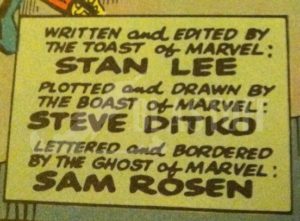Is it weird to be nostalgic for a time period you weren’t around for to enjoy? Technically, I guess it’s not possible. But as I’ve read over a handful of Marvel Silver Age books this month, I can’t help but daydream about being a comic book reader in that time.
It was a period of prolific creation and general excitement about the comics industries. Issues flew off racks, iconic characters were being created or fleshed out. Writers sat in bullpens and fed off each other’s creativity. And the stories rolled. Comics today aren’t the same. I mean, duh, of course they’re not, but there are a lot of things to love about the Silver Age that we just don’t get now.
Mostly? Everyone wasn’t so terribly serious all the time. No one had yet decided that the dark, gritty, brooding superhero story should be the standard. The colors were brighter. Superheroes carried their burdens and tragedies but still walked with lighter steps. They actually enjoyed their powers instead of bemoaning their place in the world (okay, most of them did). Villains could be simultaneously bad-ass and ridiculous and they owned their corny names.
Covers listed the creative team like this, for crying out loud:
It was a time of alliterations. Peter Parker. Matt Murdock. Bruce Banner. Jonah Jameson. Stephen Strange. Scott Summers. On and on. Those names all roll right off the tongue. And when names are catchy and easy to remember, they become household names that much faster. Sure, it helped Stan Lee scroll through his memory (can you imagine all the stories vying for attention in there?) and recall the heroes and villains quicker, but it also created a trend in comics. The literary technique fit the snappy style of the Silver Age and earlier and became part of what I adore about reading that time period.
Speaking of snappy, it was a time of the faster pace. Stories weren’t stretched out over six issues. It’s been positively delightful to go from reading current comics and seeing arcs and events that offer resolution long after you stopped caring to read Silver Age stories when stuff happens in each issue. I know there are multi-part stories, too, but it didn’t seem to be the norm – not like it is now anyways. You could watch Spidey and Doctor Strange take down Xandu in 20 odd pages, and the story was done. And I’m not disappointed when I get to the end because I know there’s another fantastic villain to fight or action packed tale coming up to bat next.
The art and words matched that pace, too. It’s not a time period of few words by any stretch. In my sampling, panels without word bubbles were rare. There aren’t as many splash pages either. The language was flowery and actions and art were sometimes over explained. Even if there were occasionally too many of them, the choice of words was so spot on and so entertaining, I can’t help but eat it up. It suits the time period of the mid 50s to the early 70s perfectly.
And reading Stan Lee’s introductions is as enjoyable for me as reading the actual comics, sometimes more enjoyable. Confession: I usually skip right over intros unless they’re written by an author I know and like, but I never skip Stan’s. They’re entertaining as heck and seriously energetic. They make me want to get up and do something exciting. Not many people write like that anymore – sadly – so I eat it up. It’s one of my favorite parts about going back through time to this older stuff.
And what I particularly like about Marvel in this time period is that they didn’t go all out silly. Their comics still leaned toward lighthearted, but the characters shined above all of it. I didn’t so much get that from DC stories I read from the similar time period; all I took away from those was a sense of goofy. But with Marvel, I made friends. I pitied villains. I wasn’t just amused, I felt things. And as much as I like laughing, I like caring about characters more.


Silver Age Marvel introduced the idea that superheros could have flaws. You could take any character in the Silver Age Justice League and trade out their word balloons and it wouldn’t make any difference. Marvel changed the comics world by the simple concept of having characters flaws and character development.